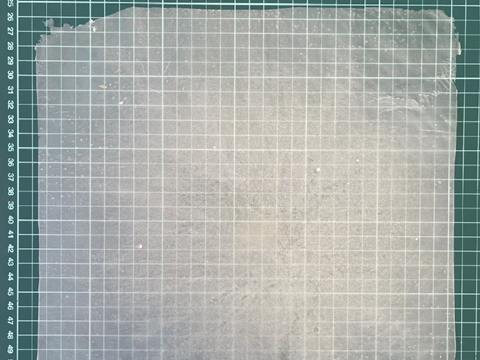
Credit: CETEC
Aiming to replace fossil-based polymers in food packaging, the European ViSS project is converting poultry waste and sugar byproducts into the biopolymer PHB – but highlights logistical and financial roadblocks in the process.
Every European citizen was reported to generate 186.5 kilograms of packaging waste in 2022; this apparently marks an increase of 29 kilograms per person since 2011.
Within this figure, 19% of the waste generated was said to be made of plastic – nearly 37% of all food sold in the EU is wrapped in plastic – but only 41% of it is believed to have been recycled.
“We have an increase in the use of packaging and especially single-use,” explains Samy Porteron, programme manager at the Environmental Coalition on Standards (ECOS). “Consequently, the EU’s total packaging waste rose by some 20% over the last ten years.
“So first we must reduce packaging. We advocate for not using any packaging whenever that’s possible.”
Multi-material food packaging, such as paper lined with plastic, has also posed challenges, since the material components require separation to be recycled. If taking the components apart is even possible, consumers do not always make the effort to do so.
“Consumer habits are hard to change,” says Prospero Di Pierro, professor of biochemistry at the University of Naples Federico II. “It’s difficult to imagine fruit or bread packaging without a plastic window to see the product.”
Bioplastics are described as ‘a natural remedy but not a definitive solution’. ViSS emphasizes that they can simultaneously come from natural sources and fall short of recyclability and compostability; they may only break down under specific composting conditions and/or contain PFAS, or ‘forever chemicals’, that leach into the environment.
“People might not understand that a biodegradable plastic should not be thrown in the environment because it might not actually biodegrade as quickly as you think,” Porteron continues. “They might not understand that a compostable product should not be recycled, for instance.
“Instructions for citizens for the separate collection of biodegradable plastic differ from one municipality to another, adding to the confusion.”
Di Pierro proposes a solution: “PHA biopolymers are the best candidates to replace plastic. Within this family, there’s PHB: imagine a pearl necklace where each pearl is made up of 4 carbon atoms and 2 oxygen atoms (hydroxybutyrate).
“This gives it better technological characteristics and makes it the most promising material in current research.”
According to ViSS, a microorganism digests the substrate and accumulates PHBV inside its cells. This can be extracted and purified to form a biodegradable powder or plastic granule, which can be formulated and turned into packaging, film, or other products.
“One of the main points is that in our process, our product has 15 to 30% of hydroxyvalerate,” says Carmen Fernández Ayuso, PhD, ViSS project coordinator and head of coordination and R&D management at Centro Tecnológico del Calzado y el Plástico (CETEC) in Murcia, Spain. “That makes it less crystalline and it has flexibility.”
“The addition of external molecules such as valerate to improve the polymer’s properties raises the cost if microorganisms capable of autonomous production are not available,” Di Pierro suggests.
Ayuso Fernández continues: “Our polymers are biobased and biodegradable, produced by microorganisms; they are completely safe and biodegradable in all environments: in soil, in freshwater, in seawater because we only add safe and sustainable additives.”
Explaining that the additives don’t affect the degradation process, Ayuso Fernández adds: “This is an innovative approach in our project because we design the polymer taking into account the end of life to ensure a safe biodegradation and not endangering the environment and the health of users.”
In order to cut down on transport costs, Ayuso Fernández recommends locally sourcing poultry waste, feathers, and bones, as well as byproducts from the sugar industry; using plastic reactors instead of ‘costly’ steel reactors; and conducting the whole process under non-sterile conditions.
Yet the production of this biopolymer comes with challenges, including the pretreatment of food waste to be used as raw material. Microorganisms must be fed with a ‘carbon-rich but nitrogen-poor’ substrate to produce PHA at scale, but processes like deproteinization and fermentation are reported to be costly and ‘not always scalable’.
“Then there’s the logistics,” says Di Pierro. “Transporting highly perishable materials to biopolymer factories is complex.
“Setting up facilities near food industries? Culturally, it’s hard to convince food producers to start making bioplastics and economically it doesn’t work yet, because bioplastic, being much more expensive than conventional plastic, isn’t competitive without incentives.”
Going forward, experts point out the current expense of bioplastics compared to fossil-based plastics and imports from outside the EU. They call for policies supporting the competitiveness of bioplastics produced in Europe and help scale PHBV biopolymer cost-effectively.
In similar news, Lignin Industries has just raised €3.9 million in funding to accelerate the scale-up of its biobased thermoplastic derived from lignin. The company aims to end the packaging industry’s reliance on fossil-based plastics.
Metpack has also utilized BASF’s ecovio 70 PS14H6 biopolymer in its Ezycompost coated paper and paperboard. Approved for food contact by the Food and Drug Administration (FDA), it claims to be suitable for hot and cold cups, pots and trays, and can reportedly be composted in garden home compost without leaving ‘persistent’ microplastics behind.
Click here to read the original article, which was created by the VISS project and its communication team.
If you liked this story, you might also enjoy:
Reuse vs. single use – which is better for the environment?
Sustainable Innovation Report 2025: Current trends and future priorities
What can the world learn from South Korea’s world-leading performance in plastics circularity?





















No comments yet